
The pygmy right whale may be a member of the cetotheres, a family of baleen whales, which until 2012 were thought to be extinct; C. marginata has otherwise been considered the sole member of the family Neobalaenidae. First described by John Edward Gray in 1846, it is the smallest of the baleen whales, ranging between 6 and 6.5 metres in length and 3,000 and 3,500 kilograms in mass. Despite its name, the pygmy right whale may have more in common with the gray whale and rorquals than the bowhead and right whales.

The marginated tortoise is a species of tortoise in the family Testudinidae. The species is endemic to Greece, Italy, and the Balkans in Southern Europe. It is the largest European tortoise. The marginated tortoise is herbivorous, and hibernates for the winter.
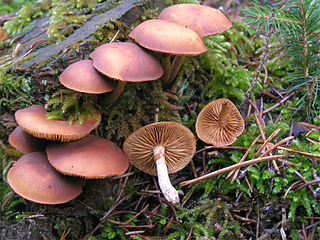
Galerina is a genus of small brown-spore saprobic mushrooms, with over 300 species found throughout the world, from the far north to remote Macquarie Island in the Southern Ocean. Species are typically small and hygrophanous, with a slender and brittle stem. They are often found growing on wood, and when on the ground have a preference for mossy habitats. This group is most noted for toxic species which are occasionally confused with hallucinogenic species of Psilocybe.
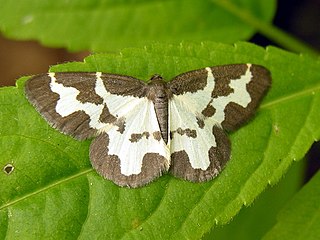
The clouded border is a moth of the family Geometridae. The species was first described by Carl Linnaeus in his 1758 10th edition of Systema Naturae. It is distributed across most of Europe to the Urals, western and central Siberia, Transbaikalia, Kazakhstan, Tian-Shan, northern Mongolia and parts of the Near East.

Banksia subg. Banksia is a valid botanic name for a subgenus of Banksia. As an autonym, it necessarily contains the type species of Banksia, B. serrata. Within this constraint, however, there have been various circumscriptions.
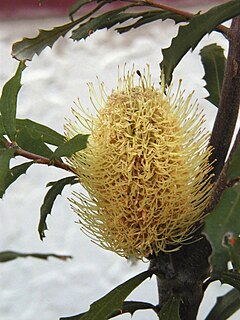
Banksia canei, commonly known as the mountain banksia, is a species of shrub that is endemic to southeastern Australia. It is generally encountered as a many-branched shrub that grows up to 3 m (10 ft) high, with narrow leaves and the yellow inflorescences appearing from late summer to early winter. The old flowers fall off the spikes, and up to 150 finely furred follicles develop, which remain closed until burnt in a bushfire. Each follicle bears two winged seeds. Response to fire is poorly known, although it is thought to regenerate by seed. Birds such as the yellow-tufted honeyeater and various insects forage among the flower spikes. It is frost tolerant in cultivation, but copes less well with aridity or humidity, and is often short-lived in gardens. One cultivar, Banksia 'Celia Rosser', was registered in 1978, but has subsequently vanished.

Banksia marginata, commonly known as the silver banksia, is a species of tree or woody shrub in the plant genus Banksia found throughout much of southeastern Australia. It ranges from the Eyre Peninsula in South Australia to north of Armidale, New South Wales, and across Tasmania and the islands of Bass Strait. It grows in various habitats, including Eucalyptus forest, scrub, heathland and moorland. Banksia marginata varies widely in habit, ranging from a 20-centimetre (7.9 in) shrub to a 12-metre (40 ft) tree. The narrow leaves are linear and the yellow inflorescences occur from late summer to early winter. The flower spikes fade to brown and then grey and develop woody follicles bearing the winged seeds. Originally described by Antonio José Cavanilles in 1800, further collections of B. marginata were designated as several separate species by Robert Brown in 1810. However, all were reclassified as a single species by George Bentham in 1870. No distinct subspecies have been recognised by Banksia expert Alex George, who nonetheless concedes that further work is needed.

Banksia kingii is an extinct species of tree or shrub in the plant genus Banksia. It is known only from fossil leaves and fruiting "cones" found in Late Pleistocene sediment at Melaleuca Inlet in western Tasmania. These were discovered by Deny King in the workings of his tin mine. The climate was most likely as cool as or cooler than it is at Melaleuca now , and possibly wetter, over 2400 mm annually.
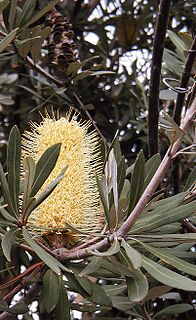
Banksia ser. Salicinae is a valid botanic name for a series of Banksia. First published by Carl Meissner in 1856, the name has had three circumscriptions.
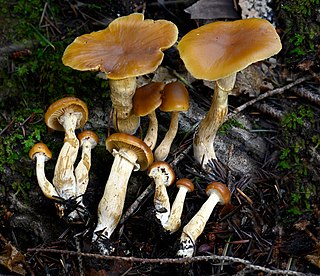
Galerina marginata, known colloquially as the funeral bell or the deadly skullcap, is a species of poisonous fungus in the family Hymenogastraceae of the order Agaricales. Prior to 2001, the species G. autumnalis, G. oregonensis, G. unicolor, and G. venenata were thought to be separate due to differences in habitat and the viscidity of their caps, but phylogenetic analysis showed that they are all the same species.
Carl Meissner's taxonomic arrangement of Banksia was published in 1856, as part of his chapter on the Proteaceae in A. P. de Candolle's Prodromus systematis naturalis regni vegetabilis. It was the first attempt to provide an infrageneric classification for the genus, aside from Robert Brown's publication of two subgenera in 1810. Meissner's arrangement stood until 1870, when it was superseded by the arrangement of George Bentham. Meissner's arrangement was an excellent survey of the known species at that time, but his infrageneric taxa were all highly heterogeneous.

Jarrah Forest is an interim Australian bioregion located in Western Australia. The Jarrah Forest comprises reserves across the south-west corner of WA and is managed for uses including recreation. There are many small areas of parkland while larger protected areas include the Dryandra Woodland, Lane-Poole Reserve, and the Perup Forest Ecology Centre. Also managed for land uses such as water, timber and mineral production, recreation and conservation, the forest is recognised globally as a significant hotspot of plant biodiversity and endemism.

Lehmannia marginata is a species of air-breathing land slug, a terrestrial pulmonate gastropod mollusk in the family Limacidae. Sometimes classified in the genus Limax, the species is distinct in its ecology, and its nearly transparent body. It is a medium-sized species, rarely exceeding 12 cm in body length. The body is fairly long and narrow, with a marked keel. The keel looks lighter than the remaining body against the darker innards.

Ropalidia marginata is an Old World species of paper wasp. It is primitively eusocial, not showing the same bias in brood care seen in other social insects with greater asymmetry in relatedness. The species employees a variety of colony founding strategies, sometimes with single founders and sometimes in groups of variable number. The queen does not use physical dominance to control workers; there is evidence of pheromones being used to suppress other female workers from overtaking queenship.

Persoonia marginata, commonly known as the Clandulla geebung, is a plant in the family Proteaceae and is endemic to New South Wales. It is low, spreading shrub with elliptic to egg-shaped leaves and small groups of cylindrical yellow flowers.
Legerella is a genus of parasitic alveolates of the phylum Apicomplexa. Species in this genus that usually infect the malpighian tubules of invertebrates.
Lankesterella is a genus in the phylum Apicomplexa. Species in this genus infect amphibians.

Hakea marginata is a shrub in the family, Proteaceae and is endemic to an area in the Mid West, Wheatbelt, Peel, South West, Great Southern and Goldfields-Esperance regions of Western Australia.
Hemiclepsis is a genus of leeches belonging to the family Glossiphoniidae.














